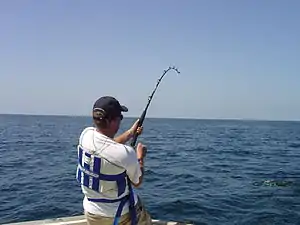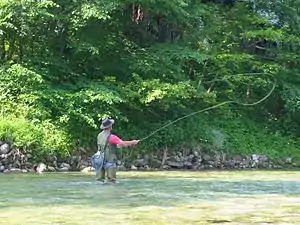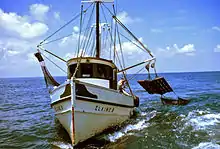Casting (fishing)
In angling, casting is the act of throwing bait or a lure using a fishing line out over the water using a flexible fishing rod. The usual technique is for the angler to quickly flick the rod from behind toward the water.[1] The term may also be used for setting out a net.
.jpg.webp) Casting at Golden Gate Angling & Casting Club, San Francisco, California | |
| Highest governing body | International Casting Sport Federation |
|---|---|
| First contested | England and United States, late 19th century |
| Characteristics | |
| Contact | No |
| Mixed gender | No |
| Type | Throwing sport |
| Presence | |
| Country or region | Worldwide |
| Olympic | No |
| World Games | 1981, 1985, 1993 – 2005 |
There are several techniques anglers use to attempt to cast further,[2] the most prominent of which is the shifting of body weight towards the front foot in correlation to the forward movement of the rod. That combined with stopping the fishing rod at 45 degrees and using the correct fishing tackle will help anglers cast further.
FALLING GEAR.
Introduction. Falling gear is a conc-shaped net that is designed to capture prey from above, by dropping ( falling) on them or to cover aquatic animals and closing in around themby trapping them. They can be used from shore or from a boat( like the stick-held cast net) and are generally operated in shallow water.
Falling gear are referred to as cast nets. It is a traditional fishing gear which is common among small scale fishermen which dwell near the coast or river banks.
In shallow water, it is used by a single fisherman with or without a bamboo raft. The fishing gear is mainly for daily human consumption. Before casting the net, the area is scours for school or individual fish by fishermen. In areas where it is not that deeper waters, the men cast the nets from a bamboo raft or banca and at the same time by releasing an extra length of the line to ensure the net reaches the bottom of the sea. The net is retrieved by pulling the length line(retrieving line).
Target species: They include ; small sardines, scads, mackerels, mullet, shrimps,squids .
Types. They are two main types of falling gear which include; cast nets( Rambots) and cover pots.
1. CAST NETS( RAMBOTS).
They are made up of circular, conc-shaped net which can be in various sizes with weight attached to it at regular intervals around the nets perimeter. When "cast" into the water, the nets falls through the water and the weight at the nets edges cause it's to close, capturing any organism(fish) inside. The gear is retrieved through the use of an attached line casting can occur from shore or small boats within shallow waters. Cast nets are subdivided into two that is
A) Fresh water cast nets.
This gear was simply used by fishermen but in recent years, it's now limited. The net is made of nylon multifilament and the net is 4m long with a 22m mouth circumference and a mesh size of 13mm. The mouth circumference consist of 120 pockets with each pocket measuring 15cm long and 50cm high. The lead or iron cabin which are attached to the bottom cage are sinkers. The apex of the net is 3.5m and it's tied as the retrieving line. This net design method of construction are the same for shallow and deep water operations, an example of a fish caught is squids.
B) Marine - water cast net.
The net is hand- made of nylon multifilament. The mullet cast net is 0.20mm with mesh size of 1.6m deep by 22m. The circumference rectangular shaped net between the upper part and selvage of the net. The selvage is a multifilament nylon with 25m deep mesh size and 22.4m circumference. The total length of mullet cast net is 3m and it has 90 pockets along the mouth circumference. The sardines cast net has a mesh size of 22m with a length of 9m. The mouth circumference is 40m with 75 pockets. The retrieving line is 6m long . The both cast nets are provided with lead or iron chain weight at the lead line.
USES.
- Cast nets are used to capture shoals of fish at the surface and are also used in both Marine and inland water to capture sardines, mullet, mackerels etc
- It's also used to cover stone aggregate in rivers. The stone are removed one by one until the fishes are impounded by the net.
2) COVER POTS.
They are used to capture individual fish on the bottom cover pots are used in fresh water environments.
RESTRICTIONS
Falling gear used is restricted in shallow water
Reference,
- Scafood.ocean.org.
-Map.seafdec.org.
-www.fao.org.
Casting techniques
Casting techniques vary with the type of fishing involved.
Fly fishermen use artificial flies as a lure and use lighter rods and lines. They develop much finesse casting the flies, using motions of the hand and arm, so the flies land with great accuracy into or onto the water and mimic the behaviour of real flies.
Salt water anglers usually use heavier rods and lines They often use lures and bait which are heavier than flies. Heavier again are the rods and lines used in surfcasting. Specialized, two-handed casting techniques are used to cast the lure or bait the added distances required in many cases to reach feeding inshore fish. In these casts the entire body, rather than just the arms, are utilized to deliver the cast, which may travel many hundreds of feet.
Casting as a sport
.jpg.webp)
Casting (known as Casting Sport) is also a sport adjunct to fishing, much as shooting is to hunting. The sport is supervised by the International Casting Sport Federation[3] (ICSF) which was founded in 1955 and as of April 2014 has member associations in 31 countries.[4]
The ICSF sponsors tournaments and recognizes world records for accuracy and distance. This sport uses plastic weights or hookless flies, and can be held on water or on athletic fields. There are competitive divisions for almost all types of fly, fixed spool and revolving spool tackle, and competitor classes. It has been included in the World Games (see photo)[5] and has been considered for the Olympics.
The American Casting Association held its 100th Annual Casting Championships in 2008 at the Golden Gate Angling & Casting Club.
See also
- Fly fishing
- Fly casting
- Net casting
- Reach cast
- Spey casting
- Surf fishing or beach casting
References
- C. Boyd Pfeiffer (1999). Fly Fishing Saltwater Basics: Saltwater Basics. Stackpole Books. ISBN 0-8117-2763-7.
- "How to cast further: the ultimate guide". Carp Fishing Hub. Retrieved 29 August 2014.
- http://www.icsf-castingsport.com/
- "Members – Contacts List". International Casting Sport Federation. Archived from the original on 19 April 2014. Retrieved 17 April 2014.
- "CASTING SPORT". International World Games Association. Retrieved 17 April 2014.
External links
- International Casting Sport Federation (in English)
- American Casting Association (in English)


